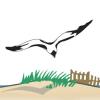Wildlife advocates from Delaware joined colleagues from Maine to Hawaii in the nation's capital Sept. 12-13 to mark the 50th anniversary of the Endangered Species Act. The gathering was organized by Defenders of Wildlife, in collaboration with other national organizations, to review the ESA's 50 years of success and its future potential.
In its first 50 years, the ESA has been credited with saving 99% of listed species from extinction. Notable success stories include the bald eagle, the American alligator, peregrine falcon, whooping crane and Kirkland's warbler. Those species, which were at risk of extinction prior to receiving ESA protection, have recovered sufficiently so that ESA protections are no longer required.
On Sept. 13, our large group split up to meet with the congressional delegations of our respective states. Delaware's contingent included conservation advocates representing Delaware Audubon, Defenders of Wildlife, the Sierra Club of Delaware, and the World Wildlife Foundation. Joined by senior staff of the American Bird Conservancy, the Delaware group met with staff members of Sen. Tom Carper, Sen. Chris Coons, and Rep. Lisa Blunt Rochester. We thanked them all for their staunch support of the ESA and other vital environmental issues, and encouraged them to defend the ESA from efforts intended to weaken it.
We used the opportunity to draw attention to the ESA-listed species that receives the greatest attention in Delaware, the red knot. Listed as threatened in 2014, the red knot has continued to drop in numbers each year during its spring stopover in Delaware, with 2023 setting a record low. The reason for its continuing decline is that the cause for its listing – the exploitation of horseshoe crabs – is not being addressed. Because of an ongoing bait harvest, the beaches on the Delaware side of Delaware Bay are barren of visible horseshoe crab eggs when red knots arrive, forcing them to bypass Delaware to survive.
The remedy is a halt to the bait harvest of horseshoe crabs, which New Jersey and, more recently, Connecticut have implemented. Legislation in Delaware is blocked by the opposition of the fishermen who feel entitled to their annual bonus paycheck for removing spawning horseshoe crabs from the beach. In Maryland, the Atlantic state that has the largest horseshoe crab quota, action to stop the bait harvest has yet to be taken.
In the face of this stalemate in Delaware, an approach to consider is to simply buy the crabbers out. Congress can help by allocating federal ESA funding for this red knot recovery effort. Our lawmakers can help by supporting this spending request that is essential to recover the red knot, conserve the horseshoe crab and ensure fair compensation for the impacted fishermen.
As the author Deborah Cramer so aptly put it, we will not know the true value of the red knot until it is gone. Fans of the red knot must continue to work so that a grim outcome never comes to pass.
























































